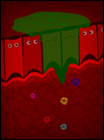Things Parents & Patients Should Know

 Adult house dust mites are so tiny they can sit on the tip of a pin. They have 8 legs and look a bit like a bag of clear jelly. An adult has a short life span of about 10 to 12 weeks. A healthy female can lay up to 3 eggs a day. After 6 to 12 days the egg will hatch producing a six-legged larva which will feed and then pass through 2 nymph stages before emerging as an adult.
Adult house dust mites are so tiny they can sit on the tip of a pin. They have 8 legs and look a bit like a bag of clear jelly. An adult has a short life span of about 10 to 12 weeks. A healthy female can lay up to 3 eggs a day. After 6 to 12 days the egg will hatch producing a six-legged larva which will feed and then pass through 2 nymph stages before emerging as an adult.
The amazing mite
 House dust mites are scavengers that have lived on earth for 23 million years. They live in colonies in nest sites of warm blooded animals such as rats, birds, and humans. To help the colony survive the mite has evolved a clever way to recycle hard-to-digest food. Powerful enzymes, placed in mite droppings, act to break down leftover scraps turning them into nourishment. The mite considers its dropping as food.
House dust mites are scavengers that have lived on earth for 23 million years. They live in colonies in nest sites of warm blooded animals such as rats, birds, and humans. To help the colony survive the mite has evolved a clever way to recycle hard-to-digest food. Powerful enzymes, placed in mite droppings, act to break down leftover scraps turning them into nourishment. The mite considers its dropping as food.
A different sort of bite by the mite
 Many people think the dust mite bites, but it does not. instead an active digestive enzyme found it its droppings can kill delicate defence cells, enter the body, and continue its journey using the blood stream. One mite enzyme has been found in the fluid surrounding unborn children.
Many people think the dust mite bites, but it does not. instead an active digestive enzyme found it its droppings can kill delicate defence cells, enter the body, and continue its journey using the blood stream. One mite enzyme has been found in the fluid surrounding unborn children.
How can I get rid of house dust mites?
There are six different ways to kill house dust mites. You can freeze, boil, poison, or microwave them, dry them up like a raisin, or put them in a hot tumble dryer for 10 minutes. The best way is to prevent them from finding a hiding place. Uncluttered rooms and micro-porous covers help. For details look further into our site.
Can you see the house dust mite?
![]() No, they are so small (0.3mm) that you need a magnifying glass to see them. If you do see mites without any magnification, they could be a different kind of mite!
No, they are so small (0.3mm) that you need a magnifying glass to see them. If you do see mites without any magnification, they could be a different kind of mite!

Mites eat organic debris
House dust mites eat moulds, fungi, dead mites, bacteria, pollen, or almost anything organic, but their favourite food is mouldy old discarded skin scales.
Why house dust mites cause disease
 In order to turn hard-to-digest food into an easy meal the mite places active digestive enzymes into its dry droppings. These enzymes stay in the droppings until they meet a moist surface. If the moist surface happens to be delicate human tissue, then the enzyme will starting working there too. This action can result in immune responses or disease.
In order to turn hard-to-digest food into an easy meal the mite places active digestive enzymes into its dry droppings. These enzymes stay in the droppings until they meet a moist surface. If the moist surface happens to be delicate human tissue, then the enzyme will starting working there too. This action can result in immune responses or disease.
Children are at risk
Children are recognised as the most vulnerable group to suffer from mite related allergic diseases. Not only because they spend more time in bed asleep (a favourite mite home) but because they are unable to identify allergy symptoms nor can they understand the need for solutions.
